

Global Leadership and Organizational Behavior Effectiveness Research Project. Cross-Cultural Competency (C3)[edit] A set of 40 general cross-cultural learning statements (knowledge, skills, and personal characteristics) were recommended by a DoD focus group in order to foster the career development of cross-cultural competence in military and civilian personnel.[2] Geert Hofstede[edit]
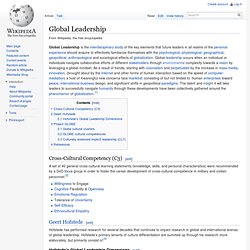
Dimensions. Means-oriented vs.
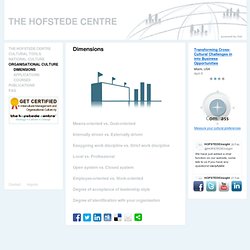
Goal-oriented The means-oriented versus goal-oriented dimension is, among the six dimensions, most closely connected with the effectiveness of the organisation. In a means oriented culture the key feature is the way in which work has to be carried out; people identify with the “how”. In a goal-oriented culture employees are primarily out to achieve specific internal goals or results, even if these involve substantial risks; people identify with the “what”. Authentic Leadership in Action. Dix commandements pour une entreprise à l’épreuve du futur. De nos jours, il devient difficile d’ignorer que les mécanismes par lesquels nous produisons et consommons notre richesse montrent enfin des signes de changement.
College of Business — GLOBE Project — New Mexico State University. Global Leadership and Organizational Behavior Effectiveness (GLOBE) GLOBE is a multi-phase, multi-method research project in which investigators around the world examine the inter-relationships between societal culture, organizational culture, and organizational leadership.
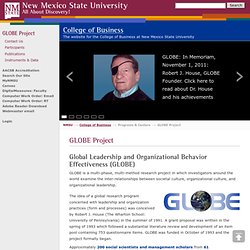
The idea of a global research program concerned with leadership and organization practices (form and processes) was conceived by Robert J. House (The Wharton School: University of Pennsylvania) in the summer of 1991. Global Leadership. Cross-Cultural Competency (C3)[edit] A set of 40 general cross-cultural learning statements (knowledge, skills, and personal characteristics) were recommended by a DoD focus group in order to foster the career development of cross-cultural competence in military and civilian personnel.[2] Geert Hofstede[edit]
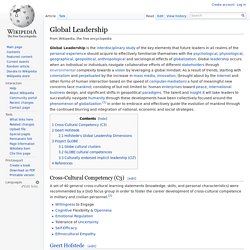
International Leadership Association. Category:Leadership. LeadingThoughts @ LeadershipNow.com. Sin Jefes: The Leaderless Academic Community. To begin with a stupid, but not snide, question: if your university or college has a president, who elected him?
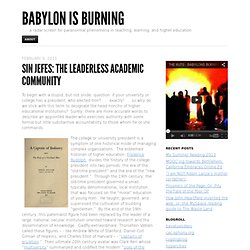
. . . exactly! . . .so why do we stick with this term to designate the head honcho of higher educational institutions? Surely, there are more accurate words to describe an appointed leader who exercises authority with some formal but little substantive accountability to those whom he or she commands. The college or university president is a symptom of one historical mode of managing complex organizations. The esteemed historian of higher education, Frederick Rudolph, divides the history of the college president into two periods: the era of the “old-time president” and the era of the “new president.”
Veblen’s witticism points to the parallels between the emergence of the American corporation – - large, national, complex, hierarchical – - with its “captains of industry” and the rise of the similarly complex, hierarchical, and bureaucratic American university. Pyramid_lg.jpg (Image JPEG, 1224 × 792 pixels) The World’s 50 Most Innovative Companies 2012. Global Leadership Civilization. Global Leadership Summit at London Business School. The rapid advance of technology in the digital age has had a profound impact on society, politics and the economy.

Geographic and cultural boundaries have become blurred, traditional hierarchies have been challenged and business leadership redefined. The 7 characteristics of powerful visions for effective leadership. ‘Visionary leadership’ is one of the phrases most bandied about these days, yet it is almost always an aspiration rather than a description.
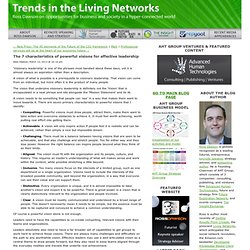
A vision of what is possible is a prerequisite to visionary leadership. That vision can come from an individual, but more often it is the product of many people. The vision that underpins visionary leadership is definitely not the ‘Vision’ that is encapsulated in a neat phrase and sits alongside the ‘Mission Statement’ and its ilk. A vision needs to be something that people can ‘see’ in a way that makes them want to move towards it. There are seven primary characteristics to powerful visions that I identify: - Compelling. . - Achievable. Collective Intelligence and Collective Leadership: Twin Paths to Beyond Chaos. - Sprouts. Conférence sur le management de l’intelligence collective en vidéo. 5 Characteristics of a Change Agent. Cc licensed ( BY ) flickr photo shared by visualpanic (change agents) – People who act as catalysts for change… In my work through school and organization visits, I have been fascinated to see the correlation between the speed of change and an individual who is “leading” the charge.

Leadership studies. Leadership studies is a multidisciplinary academic field of study that focuses on leadership in organizational contexts and in human life.
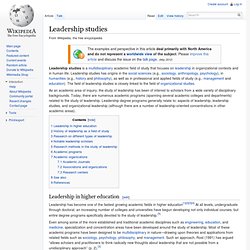
Leadership studies has origins in the social sciences (e.g., sociology, anthropology, psychology), in humanities (e.g., history and philosophy), as well as in professional and applied fields of study (e.g., management and education). The field of leadership studies is closely linked to the field of organizational studies.
As an academic area of inquiry, the study of leadership has been of interest to scholars from a wide variety of disciplinary backgrounds. Today, there are numerous academic programs (spanning several academic colleges and departments) related to the study of leadership. Leadership training, leadership tips, theory, skills, for leadership training and development. PRECEPTS OF LEADERSHIP by Louis Beam. 1.

The most important principle of leadership is to lead by example. If at all possible, a leader should have already done that which he will ask others to do. 2. Center for Leadership Studies. 6 Habits of True Strategic Thinkers. In the beginning, there was just you and your partners. You did every job. You coded, you met with investors, you emptied the trash and phoned in the midnight pizza. Now you have others to do all that and it's time for you to "be strategic. " Whatever that means. Democratic Design - Principles. After over a decade of research into what organizational democracy is, we've discovered the ten principles that it takes to cultivate a highly successful and sustainable democratic workplace. These 10 Principles of Organizational Democracy must be put into practice on both the individual and leadership levels, and be supported by democratic systems and processes to have a successful democratic organization.
Purpose and Vision A democratic organization is clear about why it exists (its purpose) and where it is headed and what it hopes to achieve (its vision). These act as its true North, offering guidance and discipline to the organization's direction. Transparency Say goodbye to the "secret society" mentality. Dialogue + Listening Instead of the top-down monologue or dysfunctional silence that characterizes most workplaces, democratic organizations are committed to having conversations that bring out new levels of meaning and connection. Fairness + Dignity Accountability. Management Theories. Governance and Decision-making tools. Organized around work. Around an evolutionary purpose. 1. Dynamic Steering: Mental shift from predicting how things will or ought to be, to discovering what is needed now based on currently known data. "Establishing tight feedback loops and frequent steer points throughout the company’s operations.
This allows planning and decision-making processes to focus on quickly reaching a workable decision and then letting reality inform the next step, rather than agonizing about what 'might' happen in an effort to conjure up a theoretical 'best' decision that still doesn’t quite get it right. " -- Organization Evolved, pg 2 2. 3. Management : Les 4 Temps du Management.
Live In Greatness. Pourquoi il y a une pénurie de grands leaders. Nous voyons de moins en moins de véritables leaders dans nos sociétés, s’inquiète James S. Rosebush, un expert du leadership qui a travaillé autrefois pour Ronald Reagan. D’un autre côté, le sujet n’a jamais été aussi discuté, ce qui semble paradoxal. Mais peut être que ces deux phénomènes sont liés : plus nous nous enfonçons dans une crise de leadership, et plus le sujet est discuté. Du point de vue de Rosebush, ce n’est pas tant qu’il n’y a plus de gens qui parviennent à développer les qualités qui font les grands leaders, c’est plutôt que le contexte de management a changé, et que les leaders d’aujourd’hui ont beaucoup plus de mal à diriger. Par le passé, les dirigeants jouissaient de certains grands avantages, estime Rosebush :
Top Employee Recognition & Global Rewards Solutions. Simon Sinek: How great leaders inspire action. 9 Personal Capacities of Authentic Leaders. I came across the book The Lotus: a practice guide for authentic leadership toward sustainability on blurb.com yesterday. Research by Baan, Long and Pearlman shows that successful sustainability leaders embody these nine personal capacities: 1. Being Present Being Present means being fully aware and awake in the present moment – physically, mentally, emotionally and spiritually. This includes connecting to otheres, the environment around you and current reality. 2. Suspension and Letting Go is the ability to actively experience and observe a thought, assumption, judgment, habitual pattern, emotion or sensation like fear, confusion, conflict or desire, and then refraining from immediately reacting or responding to the situation. 3.
Intention Aligned with Higher Purpose is the alignment of one’s authentic nature with one’s internal resonance with manifested actions in the world. 4. 5. Leadership. Un article de Wikipédia, l'encyclopédie libre. Leadership. Leadership Resource Center.
Leadership. Theories[edit] Effective Followership - Articles on Managing Up and Leading from the Middle. Followership: the Corollary to Leadership. Leadership styles. Bunker Roy: Learning from a barefoot movement. The Happy Manager, A Better Way To Manage. Complex Adaptive Leadership. Complex Adaptive Leadership. Culttural influences on Leadership & orgs.pdf (Objet application/pdf) Leadership and management in a post-modern world. Some weeks ago, I had to write a few paragraphs on how I would define good leadership and management.
The following revised essay is the result of this exercise: When the 51 founding members of the United Nations convened in San Francisco in 1945, the signed UN Charta marked a clear shift from unilateralism and colonialism to multilateralism. The main basis for this development was the growing consciousness that the existing global challenges can not be faced by one power alone.